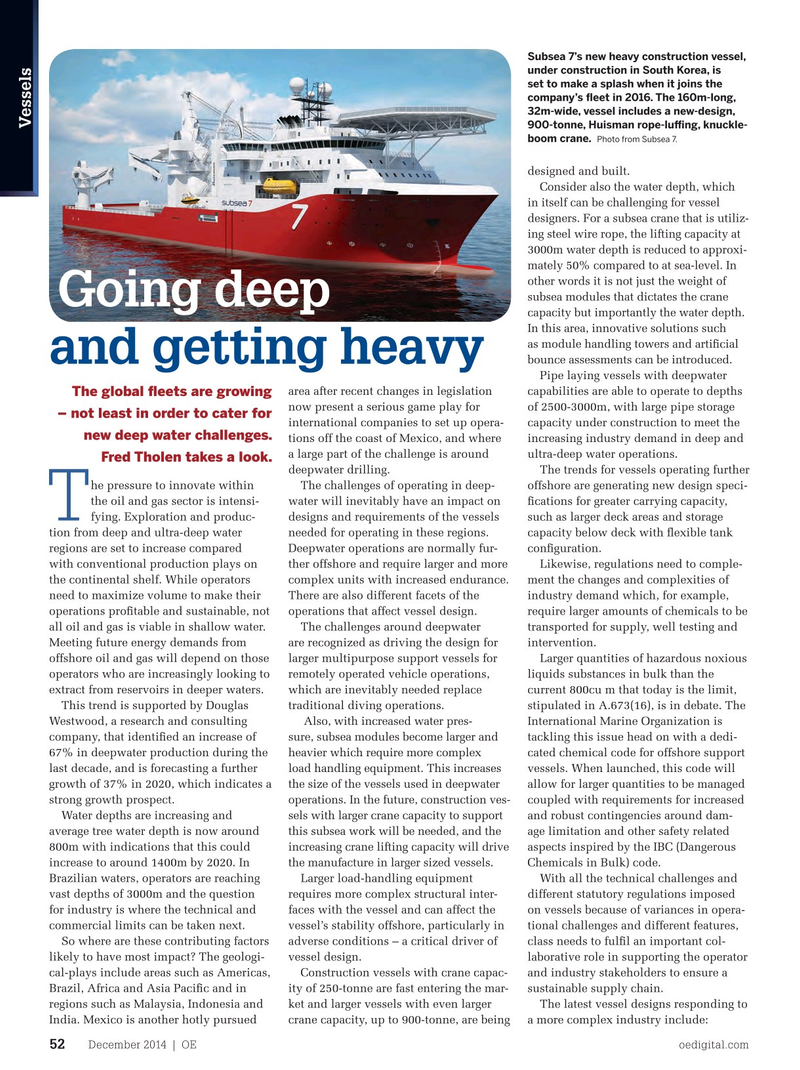
Page 50: of Offshore Engineer Magazine (Dec/Jan 2014)
Read this page in Pdf, Flash or Html5 edition of Dec/Jan 2014 Offshore Engineer Magazine
Subsea 7’s new heavy construction vessel, under construction in South Korea, is set to make a splash when it joins the company’s feet in 2016. The 160m-long, 32m-wide, vessel includes a new-design,
Vessels 900-tonne, Huisman rope-lufng, knuckle- boom crane. Photo from Subsea 7.
designed and built.
Consider also the water depth, which in itself can be challenging for vessel designers. For a subsea crane that is utiliz- ing steel wire rope, the lifting capacity at 3000m water depth is reduced to approxi- mately 50% compared to at sea-level. In other words it is not just the weight of subsea modules that dictates the crane Going deep capacity but importantly the water depth.
In this area, innovative solutions such as module handling towers and artifcial bounce assessments can be introduced.
and getting heavy
Pipe laying vessels with deepwater area after recent changes in legislation capabilities are able to operate to depths The global feets are growing now present a serious game play for of 2500-3000m, with large pipe storage – not least in order to cater for international companies to set up opera- capacity under construction to meet the new deep water challenges. tions off the coast of Mexico, and where increasing industry demand in deep and a large part of the challenge is around ultra-deep water operations.
Fred Tholen takes a look. deepwater drilling. The trends for vessels operating further he pressure to innovate within The challenges of operating in deep- offshore are generating new design speci- the oil and gas sector is intensi- water will inevitably have an impact on fcations for greater carrying capacity,
T fying. Exploration and produc- designs and requirements of the vessels such as larger deck areas and storage tion from deep and ultra-deep water needed for operating in these regions. capacity below deck with fexible tank regions are set to increase compared Deepwater operations are normally fur- confguration.
with conventional production plays on ther offshore and require larger and more Likewise, regulations need to comple- the continental shelf. While operators complex units with increased endurance. ment the changes and complexities of need to maximize volume to make their There are also different facets of the industry demand which, for example,
Experience our new Circle-H helideck lighting, aids to navigation operations proftable and sustainable, not operations that affect vessel design. require larger amounts of chemicals to be all oil and gas is viable in shallow water. The challenges around deepwater transported for supply, well testing and and remote power systems at the OSEA 2014
Meeting future energy demands from are recognized as driving the design for intervention. offshore oil and gas will depend on those larger multipurpose support vessels for Larger quantities of hazardous noxious operators who are increasingly looking to remotely operated vehicle operations, liquids substances in bulk than the extract from reservoirs in deeper waters. which are inevitably needed replace current 800cu m that today is the limit,
This trend is supported by Douglas traditional diving operations. stipulated in A.673(16), is in debate. The
Circle-H lighting
Westwood, a research and consulting Also, with increased water pres- International Marine Organization is company, that identifed an increase of sure, subsea modules become larger and tackling this issue head on with a dedi- 67% in deepwater production during the heavier which require more complex cated chemical code for offshore support
LED Marine lantern last decade, and is forecasting a further load handling equipment. This increases vessels. When launched, this code will growth of 37% in 2020, which indicates a the size of the vessels used in deepwater allow for larger quantities to be managed strong growth prospect. operations. In the future, construction ves- coupled with requirements for increased
System controller
Water depths are increasing and sels with larger crane capacity to support and robust contingencies around dam- average tree water depth is now around this subsea work will be needed, and the age limitation and other safety related 800m with indications that this could increasing crane lifting capacity will drive aspects inspired by the IBC (Dangerous increase to around 1400m by 2020. In the manufacture in larger sized vessels. Chemicals in Bulk) code.
Solar Modules
Brazilian waters, operators are reaching Larger load-handling equipment With all the technical challenges and vast depths of 3000m and the question requires more complex structural inter- different statutory regulations imposed for industry is where the technical and faces with the vessel and can affect the on vessels because of variances in opera- commercial limits can be taken next. vessel’s stability offshore, particularly in tional challenges and different features,
So where are these contributing factors adverse conditions – a critical driver of class needs to fulfl an important col-
Contact likely to have most impact? The geologi- vessel design. laborative role in supporting the operator
Come and see our full range of products www.orga-o

 49
49

 51
51